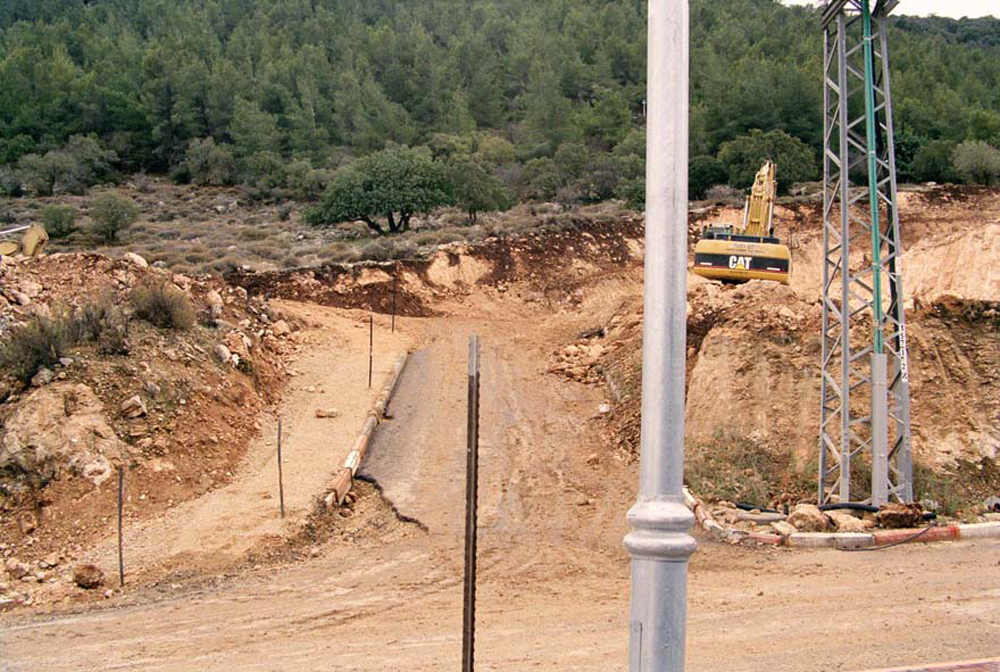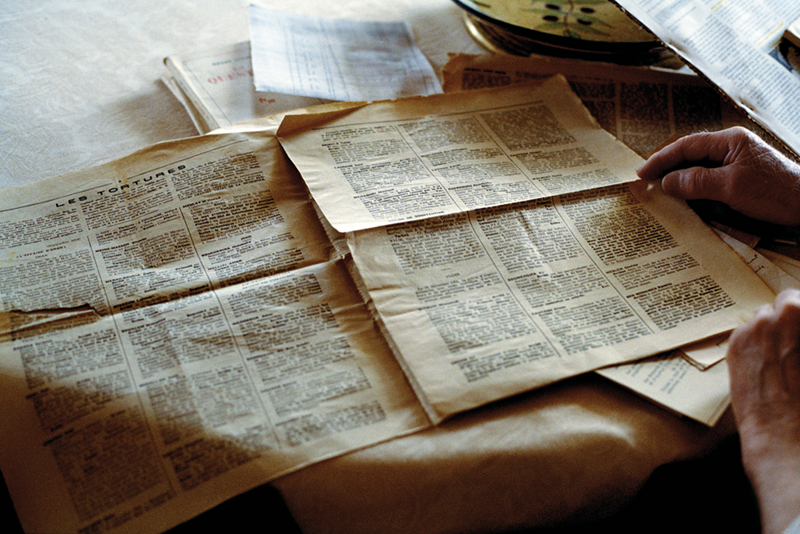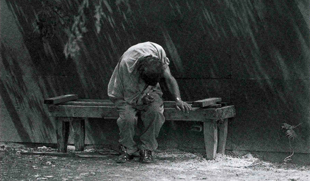—
This interview was originally published in 2008, in the catalog The anxious : five artists under the pressure of war, Yael Bartana, Omer Fast, Rabih Mroué, Ahlam Shibli, Akram Zaatari, published by Editions du Centre Pompidou on the occasion of the exhibition which took place at the Espace 315, Centre Pompidou, Musée National d’Art Moderne, Paris , 13 February to 19 May 2008.

Ahlam Shibli, untitled (The Valley no. 14), Arab al-Shibli, Palestine/Israel, 2007–08, gelatin silver print, 37.8 x 57.6 cm. Courtesy of the artist, © Ahlam Shibli
Joanna Mytkowska Could you talk about the new series of photographs, The Valley, you are preparing for the show « The Anxious » at the Centre Pompidou? As I understood it, you are investigating the impact of history on your native village, Arab al-Shibli.
Ahlam Shibli The village has a long and complex history, as do all villages in Palestine. I am trying to investigate the impact of this history through the traces it has left on the landscape, the housing and the people.
The presentvillage sits on the mountain side and no longer in the flat area. That land is now covered by a forest that didn’t exist before. The trees were planted by the Turkish and the British because they needed wood for the construction of the railway from Iraq to Haifa and down to Gaza. Some of the village people, among others my grandfather, Hassan, and his brother, Hussein, worked in the forest.
At that time, before Israel was established, the villages still had their original names, which were place names and not family names. My village, along with other Palestinian villages, had to change its name when the state of Israel was established. Its new name is Arab al Shibli which is derived from the name of the Shibli family. When the Jewish villages next to my village began developing, the Jewish state gave territories belonging to my Palestinian village to these settlements. Those changes — being pushed up the mountain out of its land and changing its place name to a family name — still affect the village today.
To change the name ofthe village was provoked by the villagers’ fear of the Israeli state punishing them for fighting for their lands in the war of 1948. This in fact refers to another work I did, Goter (2002-2003), which deals with the « recognised » and « unrecognised » villages that the Israeli government refuses to call by their original names, the place names, giving them new names, mainly names of families that live there.
We have two different situations. People who were expelled, the refugees, have a different relationship to the names of the places they left to those who stayed. The papers that prove the refugees‘ ownership of land are no longer valid, since in the official Israeli map the village does not exist anymore — its name has been changed. The action of the Israeli state is designed to delete the right of ownership and the right of memory. By deleting not only the villages themselves but also their names, it relates the Palestinians to a fantasy memory. For the people who were moved from their lands and out of their villages by the Israeli state, the change of the village name to a family name means that from now on the village moves with them and is no longer fixed to a place. It is a man and where they go the village goes with them. The people from my village, the people who stayed, have fallen into the hell of accepting the deletion of the place name by changing it to the name of the people from the village.
Now the village people are divided into two. Some of them are refugees in camps in Jordan and Syria, where they have kept the village’s original place name. The others have moved within the 1948 territories and are stuck with the village’s family name. So either you are in exile with a place name that officially doesn’t exist anymore, or you keep the family name of a village that has moved. When people from my village who live in exile ask me where I come from, I never say that I am from Arab al-Shibli. They don’t know what or where that is. I tell them that I come from Arab al-Sbaih, the original village place name that no longer exists.
From 1949 to 1966 the Palestinian people inside Israel were under the control of the military government. Like others, the people from my village couldn’t move out of the village without a permission. But it was impossible for them to get permission to leave and find work or to work on their lands, because the Jewish people there were seeking revenge on the people of my village. In 1954 a group of old men from the village went to the Catholic church, which is located on top of Mount Tabor (the village is located at its foot) and asked the priest to convert them to Christianity. The priest, Joseph, sent a letter to the Vatican asking what to do. He received permission to convert the village people and the Vatican sent him two nuns and two priests to teach them the new faith. When the local people from the military government found out about this, they came to the village and asked the villagers not to convert and allowed them to leave the village for work.
With these events in mind, I’m trying to see what the village is today. The most important factor is that the largest part of the place where the village people used to live before 1948 is now forbidden to access. Some of them continue to live there illegally. For this series on Arab al-Shibli I photographed, for instance, the place where Palestinians and Jewish newcomers made a peace agreement after a man from Mas’ha (the Jewish village close to my village, which changed its original Arab name to Kfar Tavor) had killed a person from my village. I also show a new house in the village with the Israeli flag.
JM Are there Israeli families in your village?
Ash No, it is a Palestinian family. They fly the Israeli flag as if to say, “please don’t hurt us. We are showing you our loyalty ». There’s the flag and on the other hand there are dogs and walls for protection, as if they didn’t feel safe in the village. You also see this in the landscape, with fences and border signs. Since the Israeli state pushed them up the mountain and took their land, the villagers are territorially and economically oppressed. In one photo we see new houses built on the mountain for the workers from the village. This means they have to invest a lot of money to prepare the site to build a house. Yet the land doesn’t belong to them. They lease it from the government for years. It is the perfect place to watch the Israeli government taking their land.
Another issue the spring. Fighting for water is one of the biggest issues. I show the spring of my village, which has also been taken away and is protected by a fence.
JM what is the role of photography as a medium in your work? Is it a mirror of what happened, the mirror of reality? Or is it more important for you that photography adds some additional information or value to the story? How do you see the place of your activity in that story? Are you just documenting?
Ash The important things in my work are the signs of events. The events exist for themselves. It is not me who gives them the right to exist. l’m interested in seeing and reading the signs. So it’s not a commentary.I use the images of the signs as a language, the words that make the final work.
JM As if it is a text, you are creating the images to connect one image with another. So is the series of photographs your way of creating the narration?
Ash Yes, I am not documenting reality. I am making the work out of reality by using its images. That’s why it’s much more correct to say hese are political images and not a commentary or just documentary images.

Ahlam Shibli, untitled (The Valley no. 22), Arab al-Shibli, Palestine/Israel, 2007–08, Chromogenic print, 37.8 x 57.6 cm. Courtesy of the artist, © Ahlam Shibli
JM Where is the moment of creation?
Ash Creation is the moment of choosing the signs, of determining how and where to re-contextualise them. It is giving them a new meaning and a new place.
JM But you are also leaving a space for the interpretation of your images, the different ways the viewer is going to see them, including all the mistakes and possible misunderstandings. Only when we read your text attached to the photographs does it become clear.
Ash This is why the text is part of the work. For the most part images cannot tell what they are about; images need text, as we know, they need to be titled. But let us go back to the possibility of misinterpreting my intention. I’m not afraid of this. Because first of all I believe that the images themselves have to be interesting. Their value derives both from the aesthetic and the meaningful. To avoid gross misunderstandings I address the issue, the subject matter I’m dealing with, in a text attached to the work.
Since I am interested in the sustainability of my work, it is not specifically the issue of my village. The village is used as a platform to deal with the situation of the people who stayed. My village is the small point I use to read the situation’s signs.
JM Do the images still have the power to talk about emotions? To talk beyond the text, to talk beyond the rational statements?
Ash Yes they do, maybe not in the sense I wanted. That’s why I do not place text right next to each image. I prefer to separate it from the photographs, in order to maintain this freedom of looking, to have the pleasure of seeing. This happens at an emotional level. In the end I’m doing this work for myself: I want to see it, I want to know it, and I want to read it. It’s only later that I offer it to an audience. I have the subject in my head before starting to photograph. This subject lives and moves with me. It first results in images in my head. Only afterwards I take the step to connect it to the visual images of the work. Concerning the rational statement in this work, I didn’t want to show the places where people had a fight and where people were killed. I wanted to use the simple signs around the village, which for me are far from evident, as they are not obvious and direct signs of what happened. They are signs of history’s impact on people’s situation.
JM What is interesting is that you do not only photograph your own experience, your own village in that way. You have made photographs in several other places: in Japan, in Brazil, in South Africa, in Spain, in Germany, in Switzerland. Are you using the same method everywhere or is, maybe, the method even sharper when you are looking at a place that is not so familiar to you? It seems that you have this amazing talent to detect signs —as in the photo you did in Switzerland with the guns and the clock. It is the most symbolic image I know about war, which, wherever it is happening, will sooner or later affect all of us. It seems that you started to work with this method about four years ago and now you are able to find credible signs of catastrophe everywhere— you see emigrants, you see social injustice, misery and its reasons. Do you think that the source of this vision is here, in this village?
Ash I’m dealing with the issue of home: a place as a home, which is connected to the place where you were born and grew up, physically the sense of belonging and culture… Almost everything I do is in relation to this —questioning whether it is a home and what kind of home it is. Yes, my village is my home and what happened to my home is the
source of my seeing.
JMThat is why you are so interested in the subject of the refugees, which is the opposite of home, I guess.
AshYes. The situation of refugees, on one hand, and the situation of emigrants, on the other, are important issues for me in relation to the question of home: what makes home a “home”? Being a refugee is not a choice. They were forced to move to another place. I compare this situation with the situation of emigrants. Is there a power that
determines whether they are refugees or emigrants moving from one place to another?
I researched this in a different way in my work, Eastern LGBT (2006), about transgender and homosexuals from the East who had to move to the West in order to realise their body as a home. I saw that they emigrated to the West and formed their community elsewhere but, for example, in London, they live in small communities from their countries.
The other example is my village, where the notion of home was affected by the war of 1948. More than 80 per cent of the village people became refugees, who had to leave their homeland, and the remaining 20 per cent went into hiding at Mount Tabor Monastery. They returned to their village at the end of the war, however their lands were confiscated. What are they doing? How are they surviving this situation of coercion? We see the Israeli flag on top of houses and shops, for instance.
In the Trackers series (2005), I show the situation of Palestinian people who join the Israeli army. They fight against their own people in order to survive. In the new series, The Valley, which is going to be presented in “The Anxious”, I am looking for other levels. This is why I had to find a different way to approach the village. The work is around the village, this island that was taken from them. The Israeli state is also exchanging land of people from the village with land of people in exile. This is an Israeli way to create conflict in the village and in Palestine.

Ahlam Shibli, untitled (The Valley no. 26), Arab al-Shibli, Palestine/Israel, 2007–08, Chromogenic print, 37.8 x 57.6 cm. Courtesy of the artist, © Ahlam Shibli
JM When a piece is as political as yours, one is always looking for a vision for the future. Is yours a positive proposal, even on a modest scale?
Ash In my work I propose a way of seeing. I propose not to escape the facts, by focusing on signs. I take the responsibility of seeing and offering what I see to my audience. This doesn’t offer a solution and I’m not proposing a solution. For myself I know what the solution is but it is not about putting it in the artwork. It is about bringing it to be seen.
JM You are showing something, which is not really known. You are showing, defining, giving a hint as to how you can read the situation. It’s already a lot, because if you come here, especially when you’re a stranger, your eyes are not used to reading the signs. I guess even for the people from the village it’s not a clear history…
Ash People in my village are afraid that if they talk, they will be punished by the Israeli state, which will not give them the permission to build a house or let their children work. They refuse to tell what has happened, out of fear. For me it has to be one of two choices: either you fight with a gun for your freedom or you fight with your brain. Resistance is needed in order to be free. You have to protest but never to sleep and wait. Moreover in order to solve a problem, we have to know what the problem is. The village people say, “OK. This is the situation, we are losing our lands ». We have to protest. We have to build our schools, to create a generation that cares about what is happening to it and fights for its rights.
Ahlam Shibli et Joanna Mytkowska, 2008


